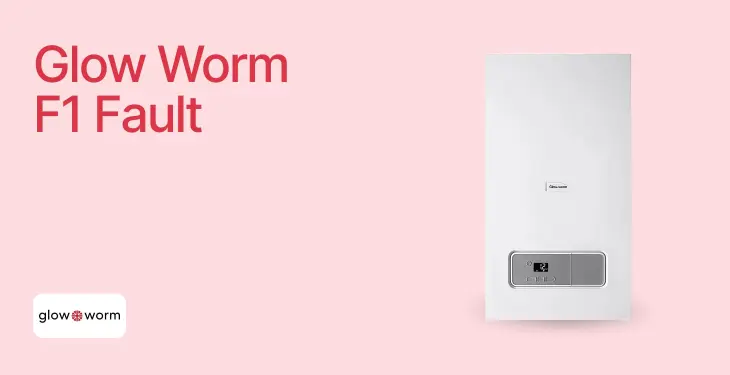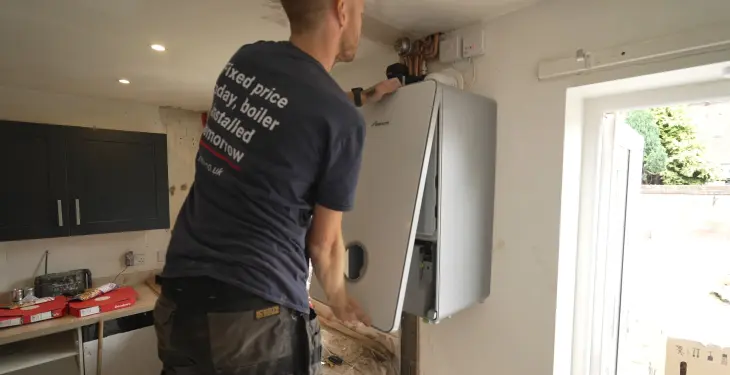

Written by Stephen Day
Gas Safe Engineer
Updated: 25th July, 2025
Boiler error codes are critical indicators for diagnosing heating system issues. They serve as the first hint of potential problems within the boiler.
Get a new boiler quote, save up to £550 per year (0% APR available).
Boiler fault codes are integral to the diagnostic systems of modern boilers, acting as the first indicator of potential issues within the unit. The Glow Worm range of boilers utilises such codes to alert homeowners and engineers to specific problems that require attention.
Among these, the F1 fault code is an important one, indicative of an issue with the boiler's ignition process.
Pinpointing the cause of an F1 fault can be complex due to the variety of components involved in the ignition sequence.
Understanding the implications of the F1 fault code is crucial for maintaining the safety and efficiency of a home heating system. The code suggests that the boiler's printed circuit board (PCB) has failed to detect a successful ignition, which could stem from several sources, including electrical part failures, gas supply issues, or condensation blockages.
This fault typically necessitates an expert assessment, as tampering with gas appliances can be hazardous and is regulated in the UK.
Get a quote in 60 seconds, fitted as fast as next day!
0% APR finance available.
Boiler error codes are critical indicators for diagnosing heating system issues. They serve as the first hint of potential problems within the boiler.
An error code on a boiler is a alphanumeric combination that instantly alerts users and engineers to a specific fault within the system. This code appears on the boiler's digital display and signifies that the boiler has detected an issue during its self-checks or operation.
The system is designed to halt operations if a fault is serious, thereby preventing damage or unsafe conditions.
Error codes cover a spectrum of issues, ranging from minor sensor faults to urgent gas supply problems. They are not universally standardised, meaning a specific code may differ in meaning across various boiler brands and models.
Understanding these error codes is essential for proper boiler maintenance. Recognising the significance of a displayed code enables homeowners to:
Communicate effectively with technicians: When a homeowner can relay the specific error code to a Gas Safe registered engineer, it allows for a more efficient diagnosis and repair process.
Make informed decisions: Depending on the code, a homeowner might know whether a simple reset is sufficient, or if professional assistance is immediately necessary.
Ensure safety: Certain fault codes might relate to gas supply or fumes, which can have serious implications for the safety of the property's inhabitants. Prompt action in response to these codes is paramount.
Thus, while homeowners needn't be experts in all nuances of boiler functioning, a basic grasp of error codes enhances both boiler care and household safety.
This section addresses the significance of the F1 fault code on Glow Worm boilers and the typical culprits causing this error.
The F1 fault code on a Glow Worm boiler is an indication that the boiler's ignition process has not been successfully completed. When this fault code is presented, it usually denotes that the boiler's printed circuit board (PCB) has not detected a flame when it expected to, as part of the boiler's normal operating sequence. A boiler will typically enter a 'lock out' state to prevent further unsuccessful ignition attempts and ensure safety.
Multiple factors can trigger the F1 fault code:
Blockages: A common issue could be blockages in critical components such as the flue or condensate pipe, which can interfere with the boiler's operation.
Gas Supply Problems: Issues with the gas valve or main gas supply can prevent the proper flow of gas, crucial for ignition.
Faulty Components:
Probes/Sensors: These are necessary to confirm ignition, if faulty, the PCB doesn't receive the correct reading.
Fan: Needed to expel flue gases, faulty operation may affect the ignition process.
Heat Exchanger: Debris here can cause overheat and subsequent ignition failure.
Electrical Failures: A faulty ignition lead, spark electrode, or connections can fail to initiate the spark necessary for ignition.
Each possible cause requires a specific solution, from cleaning blockages to replacing defective sensors or electrical components. It's important to identify the exact issue to reset the boiler and clear the F1 fault code.
Encountering an F1 fault code on a Glow Worm boiler is often a clear signal that there are issues within the ignition process. Not only does this hinder the operation of the boiler and central heating system, but it also requires decisive steps to ensure functionality is restored.
Error Display: The boiler consistently showcases the F1 code on its digital display.
Ignition Failure: Attempts to ignite the burner prove unsuccessful, indicated by the absence of the usual sounds that accompany ignition.
Lack of Hot Water and Heating: The central heating system ceases to output heat, and hot water supply is interrupted.
Flue Blockage: Sometimes a blocked flue can trigger this error; signs include unusual noises or a lack of expelled air from the flue outlet.
A multimeter can be employed to assess components like the ignition lead or electronic elements tied to the printed circuit board (PCB), which might aid in pinpointing the fault.
This should only be undertaken by a Gas Safe engineer due to the technical and safety implications.
Self-Assessment: Homeowners can conduct a basic visual check to ascertain if there are any obvious blockages or disconnected wires.
Professional Help: It is generally recommended to contact a certified Gas Safe engineer to address the F1 fault code safely. Fault determination and repair necessitate technical knowledge and the handling of potentially dangerous components.
While some minor checks and resets can be performed without professional aid, any repairs, especially those requiring the handling of the gas supply or internal components, should not be attempted. This ensures that both the integrity of the boiler and personal safety are maintained.
When confronted with a Glow Worm Boiler Fault F1, the need for a professional Gas Safe Registered Engineer cannot be overstated. Precise diagnostics and safety measures are paramount.
If you encounter the Fault F1 on your Glow Worm boiler, it indicates there is a problem with the ignition sequence. This malfunction may lead to the central heating system ceasing to operate correctly.
Immediate action: Should the boiler display an F1 error code, an attempt to reset the system may be the initial step.
Persistent issues: If the fault reoccurs or the boiler fails to ignite post-resetting, it’s imperative to contact a Gas Safe Registered Engineer.
Safety consideration: Tinkering with the boiler yourself is not advised due to potential gas leaks or other issues that could pose serious health and safety risks.
One should not underestimate the complexity of modern boiler systems, and recognising one's limits when it comes to repair is a sign of prudence.
A Gas Safe Registered Engineer is an individual who has been certified by the official Gas Safe Register, the UK's registration body for gas engineers. This accreditation is a legal requirement for anyone who wishes to carry out gas work.
Qualification: To become Gas Safe registered, engineers must prove their competence. They undergo rigorous assessments which they must pass to be certified.
Why their expertise is crucial: These professionals have a thorough knowledge of gas safety and the latest standards. They also possess the skills to pinpoint and resolve faults such as the ones indicated by the F1 error code on your Glow Worm boiler.
Legal and safety aspects: Using a non-registered engineer can invalidate warranties, potentially cause non-compliance with regulations, and, more importantly, result in unsafe repair attempts.
When faced with an F1 fault code on a Glow Worm boiler, homeowners are often concerned about the potential costs involved in rectifying the issue. The expense can vary significantly based on various factors, including the nature of the fault and the rates of the Gas Safe registered engineer tasked with the repairs.
Typically, the cost for fixing an F1 fault code on a Glow Worm boiler can range from £50 to £250. These figures represent a broad estimate, factoring in common scenarios that engineers encounter.
It is important to note that actual prices may deviate and will hinge on the intricacies of the specific servicing required.
Several elements can influence the overall cost of repair. Here they are outlined succinctly:
Complexity of the Repair: Simple issues like cleaning a blocked flue may cost less, while intricate problems requiring parts replacement will drive up expenses.
Part Replacement: Should components need replacing, the cost of these parts varies. A new fan or gas valve, for instance, may significantly escalate the final bill.
Engineer's Rates: Rates for Gas Safe engineers can differ based on geographic location, experience, and whether emergency call-out fees apply.
Boiler Access: Difficulty in accessing the boiler to diagnose or fix the issue may result in additional labour costs.
Service Duration: Repairs that take longer will naturally cost more due to the increased labour involved.
By considering these factors, homeowners can better anticipate the financial implications of an F1 fault code repair.
Matching the complexity of the problem with a qualified professional is key. Engaging with a Gas Safe registered engineer ensures that all fixes adhere to safety regulations and are conducted efficiently.
Deciding whether to repair your boiler or invest in a new one can be challenging. Assessing the severity of the F1 fault, the age of your current boiler, and contemplating the costs involved are all pertinent factors.
Severity of fault: The F1 fault indicates an ignition problem. If the issue is isolated and repair costs are low, a repair might suffice.
Frequency of breakdowns: Persistent failures signal a deteriorating boiler that may require replacement.
Performance efficiency: A boiler struggling to heat your home or consuming excessive energy costs could be due for an upgrade.
Availability of spare parts: Obsolete models might have scarce components, in which case a new boiler might be more economical.
Average lifespan: Boilers typically have a lifespan of 10 to 15 years. Beyond this, efficiency drops and issues increase.
Modern homes: Newer houses often have modern condensing boilers that are more energy-efficient and eco-friendly.
Replacement recommendations: If a boiler is nearing the end of its expected lifespan and incurring frequent repair costs, replacement is generally advised.
Boilers can be a daunting purchase for many people as they’re an appliance with a lot of responsibility, providing heat for you and your family is something you want to get right. Boilers aren’t exactly a quickly disposable item either, potentially lasting you a decade.
Effectively, new boiler cost can be split into two segments: the first is the actual boiler itself (unit price), and the second is the cost of the boiler being installed (set up) in your property by an expert engineer.
Here at iHeat, we want to remove all of this undue stress and make the decision making process of upgrading to a new central heating system, as easy as possible.
Boiler costs can vary depending on a number of factors including their brand, model, fuel, output, warranty, labour and installation type. Typically a new boiler will cost between £1,845 and £3,500, below is a list of average boiler installations offered by iHeat (guide only).
Installation Type | Price (inc VAT) | |
Combi to combi swap | £1,845 | |
System to combi conversion | £2,499 | |
New boiler install | £2,899 | |
Back boiler to a combi | £3,299 | |
System to system | £1,945 |
When addressing the F1 fault code on a Glow-worm boiler, it’s fundamental for homeowners and engineers to recognise the problem as an ignition failure. Quick diagnosis and intervention are advisable to restore boiler functionality and ensure home comfort.
Key steps include assessing the gas supply, ignition leads, and electrodes, since these components are often at the heart of ignition issues.
Cleaning or replacing the ignition probe
Inspecting the PCB for faults
Ensuring adequate gas pressure to the unit
Glow-worm boilers are designed with a series of fault codes that facilitate easier diagnosis. The F1 code, specifically, alerts to ignition problems but can be due to a variety of reasons. It is therefore crucial that each possibility is explored with due diligence.
In scenarios where multiple codes display simultaneously, such as F1 with F3 and F4, the task of pinpointing the exact issue becomes more complex. However, through a process of elimination and technical expertise, a resolution is achievable.
Should homeowners encounter the F1 fault code, they are encouraged to seek professional assistance. Attempting to rectify boiler issues without proper training can lead to further complications. Moreover, annual servicing is recommended to preclude the frequent occurrence of such faults.
Last updated: 25th July, 2025

Written by Stephen Day
Gas Safe Engineer at iHeat
Stephen Day is a Gas Safe registered and FGAS certified engineer with over 20 years of hands-on experience in the heating, cooling, and renewable energy industry, specialising in boiler installations, air conditioning, and heat pump systems.
LinkedInArticles by Stephen Day are reviewed by iHeat’s technical team to ensure accuracy and reliability.

22nd December, 2025
Based on data from over 7000 boiler installations completed by iHeat in the past 12 months...
 Read Article
Read Article

22nd December, 2025
Here’s a quick roundup of the best combi boilers for 2026.
 Read Article
Read Article

22nd December, 2025
When your old boiler breaks down and it comes time to replace it with a new one, it might...
 Read Article
Read Article
No obligation. Takes less than 60 seconds.